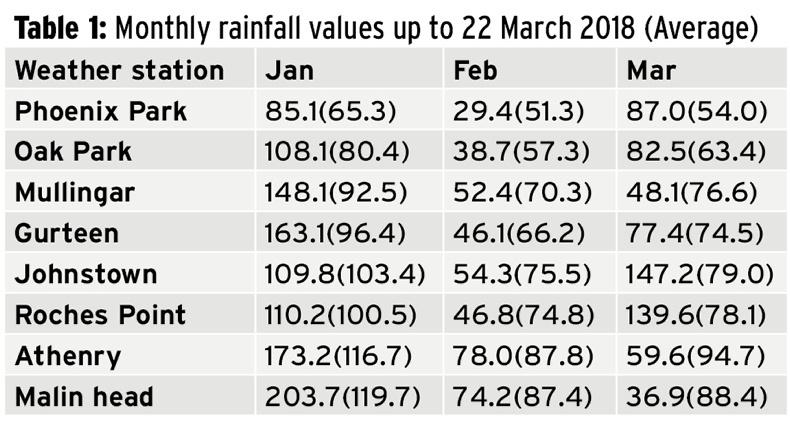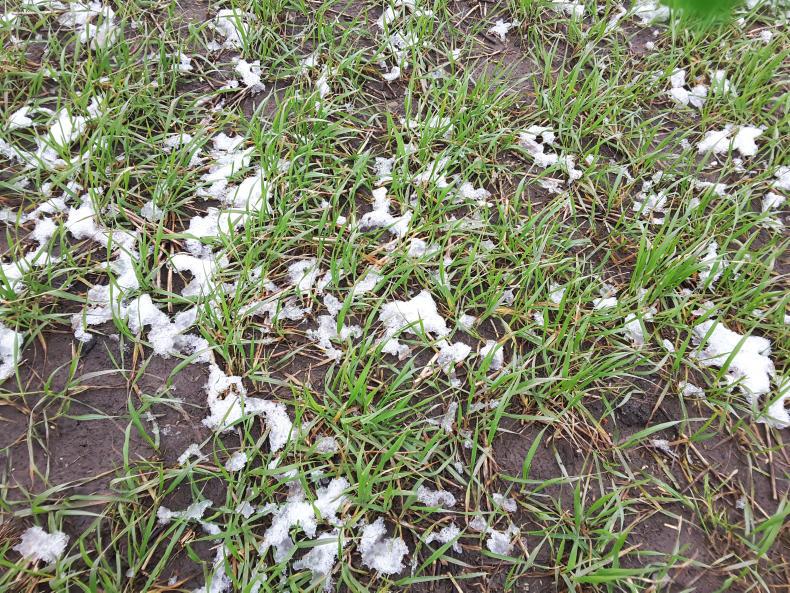As we edge closer to 1 April, who would have thought the wintry weather would still be dominating our spring? The legacy of the Beast from the East followed by wet weather, the Beast from the Beast part II and more wet weather has certainly left its mark in our fields as growth is limited and ground conditions are poor.
The wet spring has resulted in virtually every area bar the west and northwest seeing above average rainfall this month both as a result of snow and rainfall. See Table 1.

Field work has progressed in the driest regions but with some growers beginning planting last week. However, many other growers in the worst-hit regions are now well behind where they should be for this time of year. These growers may soon be forced to rethink their spring cropping plan.
Light, dry soils were trafficable over the past week but heavier soils remain saturated. Little improvement is expected over the coming number of days as wet weather is forecast for most regions.
Fertiliser
Despite lower-than-average temperatures, growth is now visible in virtually all crops. More advanced and southerly crops are now moving closer to stem extension. Winter rape is at various stages of extension and flowering. Jobs such as fertiliser now become top priority as some crops which haven't received any dressing are beginning to suffer, especially winter barley.
The priority is to get N, P and K out on winter barley and rape where these have not been applied already. Where major nutrients like N, P and K are not available in adequate quantity to fuel growth the plant will kill off smaller tillers or older leaves to free up nutrients to feed new growth.
Don’t forget to add sulphur to that list as this element is important, especially during rapid growth. For this reason it needs to be applied prior to GS31 or main split timing. Options to apply S (15-20kg S/ha) include CAN + S, Urea + S, ASN or sulphate of ammonia.
Weed control
Weed control could be on the agenda in the next number of days. Temperatures are set to dip later in the week so be mindful of this. Use products such as Alister Flex, Pacifica Plus, Picalo, Broadway Star, etc, for winter weed grassweed control. While we would have targeted IPU in the past for barley grassweed control, one of the few options now might be a Firebird DFF combination to get limited effect.
The use of pendimethalin where there are few or no weeds present may still be useful, particularly in mixes such as Flight. Where there are lots of grass weeds and nothing has been done previously, then products like Alister Flex might be considered. If you know that you will not get much meadowgrass and you have other problems like sterile brome then Broadway Star becomes the option.
Winter oilseed rape
Growers should be watching for light leaf spot (LLS). If you suspect LLS, sample leaves from the plant and put them in a bag for 48 hours. The spores will be more visible. Apply a fungicide (Proline based) if LLS is present even when they are at low levels. Teagasc states that LLS does the majority of its damage as the buds are rising through the leaves so early sprays are essential.
Read more
Winter still holds a grip on spring progress
Monday management: fertiliser and bean planting still top of the agenda
As we edge closer to 1 April, who would have thought the wintry weather would still be dominating our spring? The legacy of the Beast from the East followed by wet weather, the Beast from the Beast part II and more wet weather has certainly left its mark in our fields as growth is limited and ground conditions are poor.
The wet spring has resulted in virtually every area bar the west and northwest seeing above average rainfall this month both as a result of snow and rainfall. See Table 1.

Field work has progressed in the driest regions but with some growers beginning planting last week. However, many other growers in the worst-hit regions are now well behind where they should be for this time of year. These growers may soon be forced to rethink their spring cropping plan.
Light, dry soils were trafficable over the past week but heavier soils remain saturated. Little improvement is expected over the coming number of days as wet weather is forecast for most regions.
Fertiliser
Despite lower-than-average temperatures, growth is now visible in virtually all crops. More advanced and southerly crops are now moving closer to stem extension. Winter rape is at various stages of extension and flowering. Jobs such as fertiliser now become top priority as some crops which haven't received any dressing are beginning to suffer, especially winter barley.
The priority is to get N, P and K out on winter barley and rape where these have not been applied already. Where major nutrients like N, P and K are not available in adequate quantity to fuel growth the plant will kill off smaller tillers or older leaves to free up nutrients to feed new growth.
Don’t forget to add sulphur to that list as this element is important, especially during rapid growth. For this reason it needs to be applied prior to GS31 or main split timing. Options to apply S (15-20kg S/ha) include CAN + S, Urea + S, ASN or sulphate of ammonia.
Weed control
Weed control could be on the agenda in the next number of days. Temperatures are set to dip later in the week so be mindful of this. Use products such as Alister Flex, Pacifica Plus, Picalo, Broadway Star, etc, for winter weed grassweed control. While we would have targeted IPU in the past for barley grassweed control, one of the few options now might be a Firebird DFF combination to get limited effect.
The use of pendimethalin where there are few or no weeds present may still be useful, particularly in mixes such as Flight. Where there are lots of grass weeds and nothing has been done previously, then products like Alister Flex might be considered. If you know that you will not get much meadowgrass and you have other problems like sterile brome then Broadway Star becomes the option.
Winter oilseed rape
Growers should be watching for light leaf spot (LLS). If you suspect LLS, sample leaves from the plant and put them in a bag for 48 hours. The spores will be more visible. Apply a fungicide (Proline based) if LLS is present even when they are at low levels. Teagasc states that LLS does the majority of its damage as the buds are rising through the leaves so early sprays are essential.
Read more
Winter still holds a grip on spring progress
Monday management: fertiliser and bean planting still top of the agenda







 This is a subscriber-only article
This is a subscriber-only article











SHARING OPTIONS: